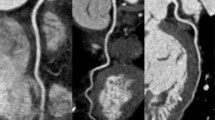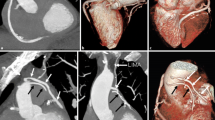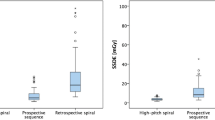Abstract
Objectives
To prospectively evaluate image quality (IQ) and radiation dose of dual-source cardiac computed tomography (CCTA) using different imaging protocols.
Methods
CCTA was performed in 150 patients using the retrospective ECG-gated spiral technique (rECG) the prospective ECG-gated technique (pECG), or the prospective ECG-gated technique with systolic imaging and automated tube voltage selection (pECGsys). IQ was rated using a 16-segment coronary artery model. Techniques were compared for overall IQ, IQ of the large and the small coronary artery segments. Effective dose was used for comparison of radiation dose.
Results
Overall IQ and IQ of the large segments showed no differences between the groups. IQ analysis of the small segments showed lowered IQ in pECGsys compared to rECG (p = 0.02), but not to pECG (p = 0.6). Effective dose did not differ significantly between rECG and pECG (p = 0.13), but was significantly lower for pECGsys (p < 0.001 vs. rECG and pECG).
Conclusion
Radiation dose of dual-source CCTA in heart transplant recipients is significantly reduced by using prospective systolic scanning and automated tube voltage selection, while overall IQ and IQ of the large coronary segments are maintained. IQ appears to be lower compared to retrospective techniques with regard to small coronary segments.
Key points
• Cardiac computed tomography angiography is useful for cardiac allograft vasculopathy assessment.
• Despite elevated heart rate, dose reduction in cardiac computed tomography is possible.
• Prospective systolic gating and automated tube voltage selection enable 50 % dose reduction.



Similar content being viewed by others
Abbreviations
- CAV:
-
Cardiac allograft vasculopathy
- CCTA:
-
Cardiac computed tomography angiography
- CTDI:
-
Computed tomography dose index
- DLP:
-
Dose length product
- ED:
-
Effective dose
- HU:
-
Hounsfield units
- ICA:
-
Invasive coronary angiography
- IQ:
-
Image quality
- MIP:
-
Maximum intensity projection
- mSv:
-
Millisievert
References
Christie JD, Edwards LB, Kucheryavaya AY et al (2012) The Registry of the International Society for Heart and Lung Transplantation: 29th adult lung and heart-lung transplant report—2012. J Heart Lung Transplant 31:1073–1086
Rahmani M, Cruz RP, Granville DJ, McManus BM (2006) Allograft vasculopathy versus atherosclerosis. Circ Res 99:801–815
Mancini D, Pinney S, Burkhoff D et al (2003) Use of rapamycin slows progression of cardiac transplantation vasculopathy. Circulation 108:48–53
Aliabadi A, Cochrane AB, Zuckermann AO (2012) Current strategies and future trends in immunosuppression after heart transplantation. Curr Opin Organ Transplant 17:540–545
Mehra MR, Crespo-Leiro MG, Dipchand A et al (2010) International Society for Heart and Lung Transplantation working formulation of a standardized nomenclature for cardiac allograft vasculopathy—2010. J Hear Lung Transplant 29:717–727
St Goar FG, Pinto FJ, Alderman EL et al (1992) Intracoronary ultrasound in cardiac transplant recipients. In vivo evidence of “angiographically silent” intimal thickening. Circulation 85:979–987
Wever-Pinzon O, Romero J, Kelesidis I et al (2014) Coronary computed tomography angiography for the detection of cardiac allograft vasculopathy: a meta-analysis of prospective trials. J Am Coll Cardiol 63:1992–2004
Mittal TK, Panicker MG, Mitchell AG, Banner NR (2013) Cardiac allograft vasculopathy after heart transplantation: electrocardiographically gated cardiac CT angiography for assessment. Radiology 268:374–381
Khan R, Jang I-K (2012) Evaluation of coronary allograft vasculopathy using multi-detector row computed tomography: a systematic review. Eur J Cardiothorac Surg 41:415–422
Einstein AJ, Henzlova MJ, Rajagopalan S (2007) Estimating risk of cancer associated with radiation exposure from 64-slice computed tomography coronary angiography. JAMA 298:317–323
Yin W-H, Lu B, Hou Z-H et al (2013) Detection of coronary artery stenosis with sub-millisievert radiation dose by prospectively ECG-triggered high-pitch spiral CT angiography and iterative reconstruction. Eur Radiol 23:2927–2933
Cerqueira MD (2002) Standardized myocardial segmentation and nomenclature for tomographic imaging of the heart: a statement for healthcare professionals from the Cardiac Imaging Committee of the Council on Clinical Cardiology of the American Heart Association. Circulation 105:539–542
Deak PD, Smal Y, Kalender WA (2010) Multisection CT protocols: sex- and age-specific conversion factors used to determine effective dose from dose-length product. Radiology 257:158–166
Hou Y, Yue Y, Guo W et al (2012) Prospectively versus retrospectively ECG-gated 256-slice coronary CT angiography: image quality and radiation dose over expanded heart rates. Int J Cardiovasc Imaging 28:153–162
Srichai MB, Barreto M, Lim RP et al (2013) Prospective-triggered sequential dual-source end-systolic coronary CT angiography for patients with atrial fibrillation: a feasibility study. J Cardiovasc Comput Tomogr 7:102–109
Kim HY, Lee JW, Hong YJ et al (2012) Dual-source coronary CT angiography in patients with high heart rates using a prospectively ECG-triggered axial mode at end-systole. Int J Cardiovasc Imaging 28(Suppl 2):101–107
Bastarrika G, De Cecco CN, Arraiza M et al (2008) Dual-source CT coronary imaging in heart transplant recipients: image quality and optimal reconstruction interval. Eur Radiol 18:1791–1799
Layritz C, Muschiol G, Flohr T et al (2013) Automated attenuation-based selection of tube voltage and tube current for coronary CT angiography: reduction of radiation exposure versus a BMI-based strategy with an expert investigator. J Cardiovasc Comput Tomogr 7:303–310
Yu L, Li H, Fletcher JG, McCollough CH (2009) Automatic selection of tube potential for radiation dose reduction in CT: a general strategy. Med Phys 37:234–243
Gonzalez-Guindalini FD, Ferreira Botelho MP, Töre HG et al (2013) MDCT of chest, abdomen, and pelvis using attenuation-based automated tube voltage selection in combination with iterative reconstruction: an intrapatient study of radiation dose and image quality. AJR Am J Roentgenol 201:1075–1082
Miller CA, Chowdhary S, Ray SG et al (2011) Role of noninvasive imaging in the diagnosis of cardiac allograft vasculopathy. Circ Cardiovasc Imaging 4:583–593
Mettler FA Jr, Bhargavan M, Faulkner K et al (2009) Radiologic and nuclear medicine studies in the United States and worldwide: frequency, radiation dose, and comparison with other radiation sources–1950–2007. Radiology 253:520–531
Noor M, Shekhdar J, Banner NR (2011) Radiation exposure after heart transplantation: trends and significance. J Heart Lung Transplant 30:309–314
Westwood ME, Raatz HDI, Misso K et al (2013) Systematic review of the accuracy of dual-source cardiac CT for detection of arterial stenosis in difficult to image patient groups. Radiology 267:387–395
Neefjes LA, Dharampal AS, Rossi A et al (2011) Image quality and radiation exposure using different low-dose scan protocols in dual-source CT coronary angiography: randomized study. Radiology 261:779–786
Sun Z, Ng K-H (2012) Prospective versus retrospective ECG-gated multislice CT coronary angiography: a systematic review of radiation dose and diagnostic accuracy. Eur J Radiol 81:e94–100
Fuchs TA, Stehli J, Bull S et al (2014) Coronary computed tomography angiography with model-based iterative reconstruction using a radiation exposure similar to chest X-ray examination. Eur Heart J 35:1131–1136
Kobashigawa J (2014) Coronary computed tomography angiography: is it time to replace the conventional coronary angiogram in heart transplant patients? J Am Coll Cardiol 63:2005–2006
Acknowledgments
The scientific guarantor of this publication is Florian Wolf. The authors of this manuscript declare no relationships with any companies whose products or services may be related to the subject matter of the article. The authors state that this work has not received any funding. Veronika Schöpf kindly provided statistical advice for this manuscript. Institutional review board approval was obtained. Written informed consent was obtained from all subjects (patients) in this study. None of the study subjects or cohorts have been previously reported. Methodology: prospective, randomised controlled trial, performed at one institution.
Author information
Authors and Affiliations
Corresponding author
Rights and permissions
About this article
Cite this article
Beitzke, D., Berger-Kulemann, V., Schöpf, V. et al. Dual-source cardiac computed tomography angiography (CCTA) in the follow-up of cardiac transplant: comparison of image quality and radiation dose using three different imaging protocols. Eur Radiol 25, 2310–2317 (2015). https://doi.org/10.1007/s00330-015-3650-2
Received:
Revised:
Accepted:
Published:
Issue Date:
DOI: https://doi.org/10.1007/s00330-015-3650-2




